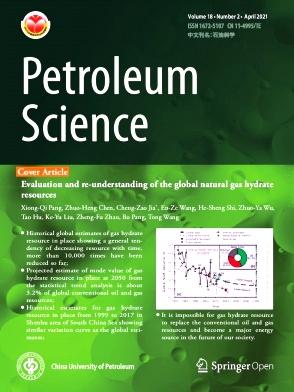合成耐温耐盐硅点,在致密油藏中有效提高石油采收率
IF 6
1区 工程技术
Q2 ENERGY & FUELS
引用次数: 0
摘要
致密油藏的大力开发使其成为常规油气资源的战略替代品。现有的提高石油采收率(EOR)方法难以有效开采储层石油,导致采收率较低。开发致密油藏急需新颖有效的方法。随着对降低注水压力和增加注水量机制的深入研究,纳米材料在提高水淹效率方面的应用前景广阔。然而,改善程度仍然有限。本研究通过水热合成法合成了一种硅量子点(Si-QDs)材料,并将其用于制备高效开采致密油藏的纳米流体。硅量子点的直径约为 3 纳米,呈球形结构,其表面被苯磺酸基团官能化,以提高其性能。所开发的纳米流体在 120 °C 和 60000 mg/L 的盐度条件下表现稳定,无聚集现象。岩心淹没实验证明了 Si-QDs 极具吸引力的 EOR 能力,揭示了 EOR 机理。Si-QDs 有效改善了岩石的润湿性,提高了注入流体的清扫系数,扩大了清扫区域。在这一清扫区域内,Si-QDs 能有效地从基质中剥离吸附的石油,从而提高清扫效率。此外,Si-QDs 还能改变孔隙封闭原油的状态,将其分解成更小的颗粒,以便在后续阶段更容易置换。Si-QDs 展现出令人瞩目的 EOR 潜力,使其成为有效开发致密油藏的一种前景广阔的方法。本文章由计算机程序翻译,如有差异,请以英文原文为准。
Synthesis of temperature and salt resistance silicon dots for effective enhanced oil recovery in tight reservoir
The intensive development of tight reservoirs has positioned them as a strategic alternative to conventional oil and gas resources. Existing enhanced oil recovery (EOR) methods struggle to effectively exploring reservoir oil, resulting in low recovery rates. Novel and effective means of developing tight reservoirs are urgently needed. Nanomaterials have shown promising applications in improving water flooding efficiency, with in-depth research into mechanisms that lower injection pressure and increase water injection volumes. However, the extent of improvement remains limited. In this study, a silicon quantum dots (Si-QDs) material was synthesized via a hydrothermal synthesis method and used to prepare a nanofluid for the efficient recovery of tight reservoir. The Si-QDs, with an approximate diameter of 3 nm and a spherical structure, were surface functionalized with benzenesulfonic acid groups to enhance the performance. The developed nanofluid demonstrated stability without aggregation at 120 °C and a salinity of 60000 mg/L. Core flooding experiments have demonstrated the attractive EOR capabilities of Si-QDs, shedding light of the EOR mechanisms. Si-QDs effectively improve the wettability of rocks, enhancing the sweeping coefficient of injected fluids and expanding sweeping area. Within this sweeping region, Si-QDs efficiently stripping adsorbed oil from the matrix, thus increasing sweeping efficiency. Furthermore, Si-QDs could modify the state of pore-confined crude oil, breaking it down into smaller particles that are easier to displacement in subsequent stages. Si-QDs exhibit compelling EOR potential, positioning them as a promising approach for effectively developing tight oil reservoirs.
求助全文
通过发布文献求助,成功后即可免费获取论文全文。
去求助
来源期刊

Petroleum Science
地学-地球化学与地球物理
CiteScore
7.70
自引率
16.10%
发文量
311
审稿时长
63 days
期刊介绍:
Petroleum Science is the only English journal in China on petroleum science and technology that is intended for professionals engaged in petroleum science research and technical applications all over the world, as well as the managerial personnel of oil companies. It covers petroleum geology, petroleum geophysics, petroleum engineering, petrochemistry & chemical engineering, petroleum mechanics, and economic management. It aims to introduce the latest results in oil industry research in China, promote cooperation in petroleum science research between China and the rest of the world, and build a bridge for scientific communication between China and the world.
 求助内容:
求助内容: 应助结果提醒方式:
应助结果提醒方式:


